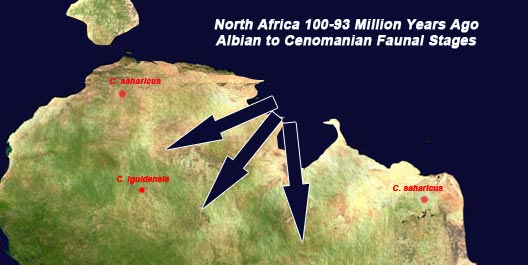Evolution and Extinction of the African Carcharodontosauridae
“Shark Toothed Lizard” – The Rise and Fall of Carcharodontosaurus
The Carcharodontosaurus genus currently consists of two species, the first of which Carcharodontosaurus saharicus (originally called Megalosaurus saharicus), is known from fossil material found in North Africa. The second species, named and described in 2007, was erected following fossil finds, including skull material from the Echkar Formation of Niger, this species is known as C. iguidensis. Although both species are known from fragmentary material and a few isolated teeth, differences in the shape of the upper jaw and the structure of the brain case enabled scientists to confidently establish Carcharodontosaurus iguidensis as a second, distinct species.
An Illustration of a Typical Carcharodontosaurid Dinosaur
Picture credit: Everything Dinosaur
Carcharodontosaurus
Carcharodontosaurus means “shark-toothed lizard”, a reference to the fact that the teeth of this huge carnivore, reminded scientists of the teeth of sharks belonging to the Carcharodon genus of sharks, such as the teeth of the Great White Shark (C. carcharias). It is ironic that this terrestrial predator should be named after a marine carnivore, as changing sea levels very probably influenced the evolution of these dinosaurs and may have ultimately led to their extinction, at least from Africa.
To view Everything Dinosaur’s range of CollectA dinosaur models including a 1:40 scale Deluxe Carcharodontosaurus: CollectA Deluxe Prehistoric Life Replicas.
Pronounced – Car-car-oh-dont-toe-sore-us, the oldest dinosaur currently assigned to the Carcharodontosauridae family is Veterupristisaurus (Vet-ter-roo-pris-tee-sore-us). This dinosaur was named and described in 2011, although the fossil material was discovered over seventy-five years ago. The fossils come from the famous Tendaguru Formation of Tanzania, it lived during the Late Jurassic and the trivial name V. milneri honours the now retired Angela Milner who worked at the Natural History Museum (London).
A Cretaceous Predator
Carcharodontosaurus lived during the Cretaceous (Late Albian to mid Cenomanian faunal stages). During this time, the great, southern super-continent called Gondwanaland continued to break up and as sea levels rose, so populations of dinosaurs became separated by the inflow of sea water.
Rising Sea Levels Influence Dinosaur Evolution
Picture credit: Everything Dinosaur
Communities became isolated and this may have provided a boost to the evolution of new species. The map shows the approximate location of fossil material associated with C. saharicus and C. iguidensis. Populations of carcharodontosaurids may have become cut-off from each other and this gave rise to new species of Carcharodontosaurus. This may help to explain the abundance of super-sized predators that lived in this part of the world during the Cretaceous.
Both species of Carcharodontosaurus shared a common ancestor, but their separation led to the evolution of two, distinct species. This natural process is called allopatric speciation.
Sadly for the mega fauna that inhabited the coastal swamps and verdant flood plains of North Africa, rising sea levels in the later stages of the Cenomanian led to the destruction of much of this habitat. The loss of habitat probably led to the demise of the ecosystem and the vulnerable apex predators such as the carcharodontosaurids and the spinosaurids became extinct.
To read an article on the discovery of C. iguidensis: New Giant Meat-Eating Dinosaur from Africa.



